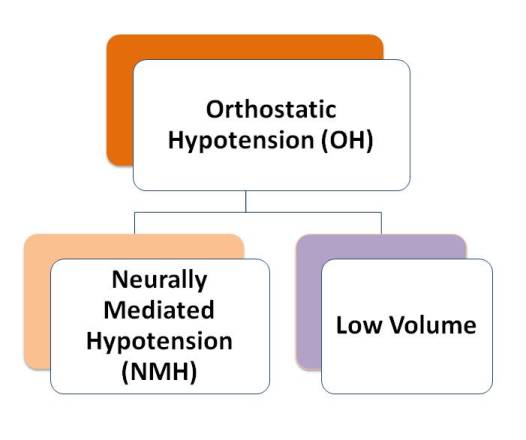Orthostatic Hypotension (OH)
Orthostatic Hypotension (OH) means the blood pressure goes down when the person stands up and the person has orthostatic symptoms, such as dizziness, lightheadedness, changes in vision, and/or weakness. There are 2 main causes of OH:
1) Neurogenic Orthostatic Hypotension (also called Neurally-Mediated Hypotension-NMH) means that it is caused by a problem in the nerves (usually the autonomic nervous system) and
2) Low blood volume (volume depletion).
A decrease in blood pressure with standing up can cause orthostatic symptoms but it can also make a person faint if the heart rate goes down.
There are 2 main causes for OH and other causes related to specific conditions.
1. A nervous system problem, specifically, the autonomic nervous system. This type of orthostatic hypotension (OH) is also called Neurally-Mediated or Neurogenic Orthostatic hypotension (NMH). It is caused by injury to the autonomic nervous system.
2. Another type of OH is 'temporary" - low blood volume. It has to do with the amount of fluid in the body, the volume of blood for the heart to pump around. It is included here because a person with OH or NMH can also get this type of OH. Being low on fluids can make the orthostatic symptoms even worse.

- OH-Definition
- NMH - Autonomic Nervous System Failure
- Who gets NMH
- OH-Low Blood Volume
- Other
The classic OH is defined as a decrease in the blood pressure (BP) when the person stands up.1 The BP goes down in the first 3 minutes after the person stands up.
To be "classic OH", the systolic blood pressure (top number) has to go down by at least 20 mm Hg or the diastolic (bottom number) drops by at least 10 mm Hg. The person gets orthostatic symptoms, like dizziness or lightheaded feeling, vision change, and feeling of weakness.
Example: The person's BP lying down is 120/80 mmHg. Pulse is 74. After standing up for 3 minutes, the blood pressure is 90/64 mm Hg. The pulse is still 74. The person feels dizzy, has vision change, & weakness. This would be "orthostatic hypotension".
The drop in blood pressure (BP) and symptoms can come at different times. Then, it has a different name. If the BP drops:
• Within 15 seconds of standing up - it's called "initial orthostatic hypotension"1
• In the first 3 minutes - it's called "orthostatic hypotension", the classic condition.1
• After 3 minutes of standing - it's called "delayed orthostatic hypotension".1
To see a comparison of the symptoms, the time symptoms develop the BP and pulse changes, and the diagnosis, go to Symptoms and Type of OI.
Orthostatic hypotension (OH) that is caused by a problem with the autonomic nervous system is also called neurogenic orthostatic hypotension and neurally-mediated hypotension (NMH).
It is a chronic condition that is debilitating; it interferes with a person's ability to live a normal life2,3. It affects a person's ability to work, to go to school, do normal everyday life things (like have fun, go out to church, shop), and take care of themselves.
What is causing it: It is called ANS "failure" because something in the ANS is not working as it is supposed to: there has been damage to the nerves or the way they handle chemicals and hormones and send messages to the rest of the body organs. It is sometimes called autonomic dysfunction or dysautonomia.
The decrease in blood pressure with standing up is due to failure of the blood vessels to constrict (get narrower) when chemical messages are sent. (medical language - sympathetic vasoconstrictor failure).
With the decrease in blood pressure, there is a decrease in blood going to the brain and other organs starting at the top of the body. The person gets orthostatic intolerance symptoms: dizziness, lightheadedness, vision changes like black spots or tunnel vision, weakness.
Fainting with OH: If the pulse (heart rate) goes down also, the person will usually faint. When there is dizziness or fainting with the OH, the person may go to the emergency room the first time (or other times if there is injury). OH may be the cause of the symptoms in about 20% of the people with these symptoms in the ER. (If 100 people with these symptoms went to the ER, 20 of them would have OH)6
About 20% of people over 65 have been reported to have their systolic blood pressure go down more than 20 mm Hg when they stood up. In another study, 18% of people over age 60 had symptoms of dizziness that was severe enough to interfere with their activities of daily lives.6
Difference in symptoms with OH6: In addition to the usual orthostatic symptoms (dizziness, lightheadedness, vision changes, weakness), people with OH do not report that they have the pallor, nausea/vomiting or clamminess (sweating).
Other findings: In OH due to dysautonomia, other findings include; mild anemia, decrease sweating, sleep apnea, hoarseness, nasal stuffiness, constipation or diarrhea, Pakrinsonian-like syndrome, recurrent urinary tract infections and/or bladder dysfunction, and impotence in men.
NMH is the most common cause of recurrent fainting. (fainting more often)
Who gets NMH depends on what group of people are being studied. In some reports, OH is more common in very old people2. It is related the types of medical problems a person has and the medications they take to manage them. With the older people, the blood pressure lying down is often high.
There is a group of younger people who develop NMH, especially women2. It is common in people with low normal blood pressure. It is also more common following infection. It is more common in those with Chronic Fatigue Syndrome (CFS). Family members are often affected. In this group, the blood pressure lying down is often low.
The hypotension may not be detected unless orthostatic stress is prolonged (delayed OH).
POTS vs. NMH - Numbers in Children: In a review of children referred for autonomic testing, Sukul and colleagues found that POTS was the most common - found in in 71% of the chilcren.9 (If 100 children were tested, 71 would have POTS. If only 4 were tested, 3 would have POTS). Orthostatic hypotension (NMH) was only present in 5%. (That would be 5 children out of 100 tested.)
For another perspective on the overlap between OH and POTS, check out Types of OI under the Causes - Dysautonomia.
In medical articles or material, a low volume of blood is referred to as "volume depletion". It can be caused by not drinking enough fluids (liquids) or the actual loss of blood.1
- Loss of fluids - or loss of blood volume. It could be volume depletion or dehydration from not drinking enough fluids. It also could be an imbalance in fluids. An imbalance means a person is losing more fluids than they take in. Fluids are lost with vomiting, diarrhea, fever, sweating a lot, and urinating a lot from drugs like diuretics. Conditions due to high outside temperatures like heat exhaustion and heat stroke have dehydration.
- Loss of blood. This is usually from bleeding. Bleeding loses both fluids in blood plasma and the red blood cells. It is measured by the hematocrit. A low number of red blood cells is called anemia. Red blood cells are critical because they carry oxygen from the lungs to the rest of the body and the cells. If the blood loss is big enough, there is a decrease in the number of cells that can carry oxygen. The cells do not get as much oxygen as they need to function. The symptoms of anemia are weakness, shortness of breath and chest pain.2
When the cause of the orthostatic hypotension (OH) is loss of volume, the pulse might actually increase. It's the body's way of trying to get the blood to the head and vital organs.
For blood loss: If the amount of blood lost is not extensive, the fluid needs to be replaced and the body will make new blood cells. If the blood loss is significant, the person may need to receive red blood as a transfusion.
Syncope (fainting) or orthostatic symptoms from orthostatic hypotension can occur with these also:
- Prolonged bedrest - If a person has been on prolonged bedrest, they might have orthostatic symptoms when they stand up7. If the bedrest has been shorter than 4 weeks, the symptoms should get better as the person gets back to normal activities. It is taught that for every 1 day of bedrest, it takes 5 days to recover. For more about bedrest and orthostatic symptoms, go to Bedrest, Bedrest and OI or Bedrest: Space flight and ICU-stays.
- Drug related: side effect of drug. This is a very common cause of orthostatic hypotension especially in older people.
- Pregnancy
- Addison’s disease (usually volume depletion)8
- Atherosclerosis – It changes the arteries and makes it difficult for them to adapt quickly to changing position.
 For more information:
For more information:
For a more complete list of symptoms of orthostatic intolerance (OI), go to Symptoms of OI
To find the type of OI by matching the time of changes in BP and Pulse and Symptoms, go to Symptoms and Type of OI.
For another perspective on the overlap between OH/NMH and POTS, check out Types of OI under the Causes - Dysautonomia.
To learn more about POTS (Postural Orthostatic Tachycardia Syndrome), go to POTS.
To learn more about fainting (syncope), reflex syncope, vasovagal syncope, go to Fainting -Types and Causes or Fainting - Reflex Syncope.
To learn more about managing OI, go to Managing OI.
References
- Moya, Guidelines for the diagnosis and management of syncope (version 2009). European Heart Journal (2009); 30: 2631-2671. Abstract. Article PDF.
- Freeman, Roy. Neurogenic orthostatic hypotension.NEJM 2008;358(6):615-624. Abstract
- Figueroa JJ, Basford JR, Low PA. Preventing and treating orthostatic hypotension: As easy as A, B, C. Cleve Clin J Med. 2010 May;77(5):298-306. Abstract. Article PDF.
- Wedro, Benjamin, Stoppler, Mellissa. Orthostatic hypotension. MedicineNet. Last accessed: June 24, 2012. Article"
- Brignole, M. The syndromes of orthostatic intolerance. E-journal of Cardiology Practice. 2007: 6(5). Access. http://www.escardio.org/communities/councils/ccp/e-journal/volume6/Pages/vol6n5.aspx
- Medow MS, Stewart JM, Sanyal S, Mumtaz A, Stca D and Frishman WH. Pathophysiology, Diagnosis, and Treatment of Orthostatic Hypotension and Vasovagal Syncope. Cardiology in Review 2008;16(1):4-20. Abstract.
- Winkelman, Chris RN, PhD, CCRN ACNP. Bed Rest in Health and Critical Illness: A Body Systems Approach. AACN Advanced Critical Care: 2009; 20(3); 254-266. Abstract.
- Brignole M. Diagnosis and Treatment of Syncope. Heart 2007: 93; 130-136. Article PDF
- Sukul D, Chelimsky TC, Chelimsky G. Pediatric autonomic testing: retrospective review of a large series.Clin Pediatr (Phila). 2012 Jan;51(1):17-22. doi: 10.1177/0009922811415102. Epub 2011 Aug 25. Abstract.
Author: Kay E. Jewell, MD
Page Last Updated: August 28, 2012
